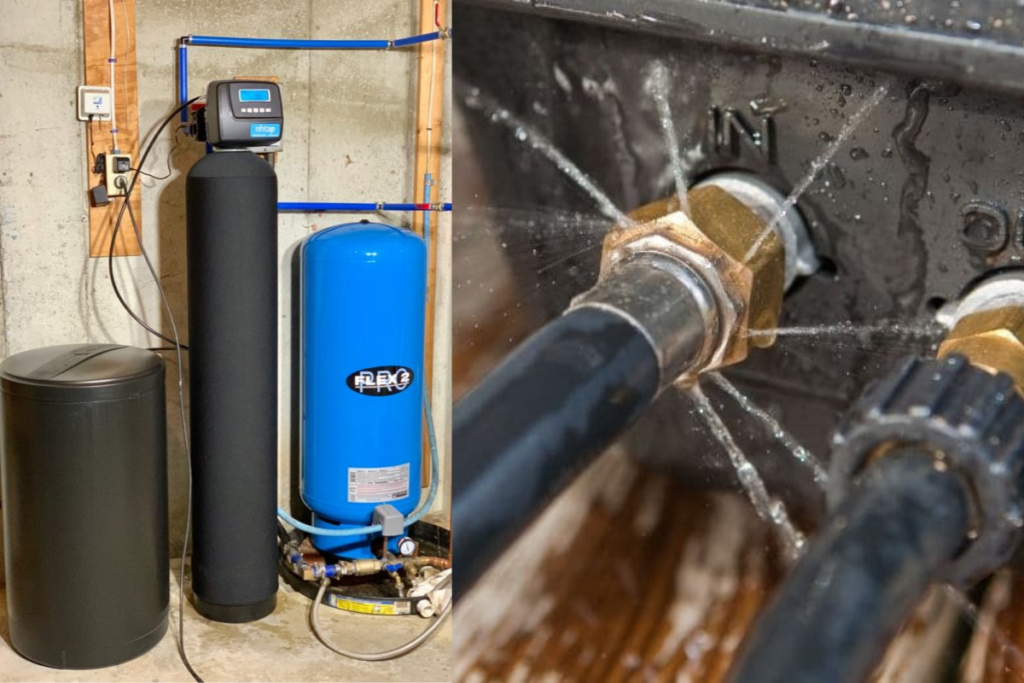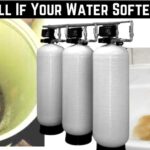You’re probably familiar with the Water Softener Brine Tank Leaking.This tank holds the salt water used to regenerate the softener.
If your brine tank is leaking, it’s essential to immediately prevent any damage.
In this post, we’ll tell you what to do if your mineral tank leaks and how to fix it. Stay tuned for more information!
Water Softener Leaking?
If your soft water softener leaks, it’s essential to act immediately.
A leak in your softener can lead to a loss of water, which can be costly, and it can also cause damage to your home.
There are a few things that you can do to fix a leaking water softener. First, you must check the connections and fittings to ensure they are tight.
If they are loose, you can tighten them with a wrench.
If the leak comes from the brine tank, you may need to replace the brine tank. This is a more severe problem; you must call a plumber or a softener repair person to fix it.
You may need to replace the unit if the leak comes from the softener itself. This is a severe problem; you should call a plumber or a softener repair person to fix it.
Once you have fixed the leak, you will want to make sure that you keep an eye on the softener to make sure that it doesn’t happen again.
This is especially important if you have an older water softener. You may need to replace some of the parts on an older water softener, or you may need to buy a new one altogether.
Whatever you do, don’t ignore a leak in your softener. It could lead to big problems down the road.
How to Diagnose My Water Softener Leaking From The Top?
There are a few reasons your softener may leak from the top. In most cases, it is due to a problem with the unit itself and will require a repair or replacement.
1. Check the connections
When you notice your softener leaking from the top, check the connections first. Ensure that all the hoses and pipes are securely connected and there are no loose fittings.If the connections seem okay
2. Inspect the tank
The next step is to check the brine tank. The saltwater solution is stored in the brine tank to soften the hard water.If the brine tank is empty, it will need to be refilled.
3. check the controls
the next step is to check the float switch. The float switch controls the flow of salt water into the brine tank.
4. Check the valves
If the float switch is not working correctly, it could be causing the leak.
If you have checked all of the above and are still experiencing a leak, it is most likely due to a problem with the unit itself. In this case, it will need to be repaired or replaced.
Why Is My Water Softener Leaking From The Bottom?

There are a few possible reasons your softener might leak from the bottom. It could be due to a loose connection, a cracked tank, or a faulty valve.
If you notice that your softener is leaking, taking action immediately is essential.
A leak can quickly lead to expensive repair bills, not to mention the hassle of constantly refilling your softener with a salt tank.
Here are a few tips on how to troubleshoot a softener leak:
1. Check the connections:
The first thing you should do is check all of the connections on your brine tank water softener. Ensure that everything is tightened securely and that the hoses have no cracks or leaks.
2. Inspect the tank:
Another possible cause of a leak is a cracked tank. Inspect your softener’s tank for any signs of damage. If you notice any cracks, replacing the entire unit is best.
3. Check the valves:
The valves on your softener can also cause leaks. If the valves are worn out or not working correctly, they may need to be replaced.
If you’re still having trouble pinpointing the source of the leak, it’s best to call a professional.
A plumber or water treatment specialist can diagnose the problem and recommend the best action.
What Causes a Water Softener Hose to Leak?
There are a few different reasons that a water softener hose may leak. Here are a few causes:
1. The softener hose may be old and need to be replaced.
2. The hose may be damaged and need to be repaired or replaced.
3. There may be a problem with the connection between the hose and the water softener unit.
4. There could be a leak in the actual water softener unit itself.
5. Another possibility is that the hose was not installed correctly and needs to be adjusted.
If you notice a leak coming from your softener hose, it is essential to take action immediately. If the leak is not fixed, it could lead to water damage in your home and expensive repairs.
Suppose you are still determining what is causing the leak. In that case, it is best to call a plumber or water softener repair expert technician. They will be able to diagnose the problem and make the necessary repairs.
How Can You Tell If Your Water Softener Is Leaking?
If your softener isn’t working correctly, it may be due to a leak. Here are a few signs that your softener is leaking:
1. You notice water usage pooling around the base of the unit.
2. Your water bill is higher than usual.
3. There is less water pressure coming from your taps.
If you notice any of these signs, you must call a plumber to come and take a look. A leak in your softener can lead to severe damage if it’s not fixed promptly.
Common Reasons and Solutions Of Softener Leaking
Softeners are an essential appliance in many homes.
They help to remove minerals from hard water, making it softer and easier on your skin, hair, and laundry.
But when a softener starts leaking, it can be a big problem. There are a few common reasons why softeners may start leaking:
1. The brine tank is overfilled:
The brine tank is where the softener stores the salt (sodium ions) it uses to remove minerals from the water. If the brine water is overfilled, it can cause water to leak out of the tank.
2. The brine tank is cracked:
A cracked brine tank can also lead to water leaking out.
3. The brine tank valve is leaking:
The brine tank float valve has a rotor valve that controls head the overflow issues of water into and out of the tank float valve.
If this rotor valve leaks, it can cause water to leak from the faulty tank.
4. The softener is not draining correctly:
If the softener is not draining correctly, it can lead to water buildup and leaking.
If your standard water softener leaks, check the brine tank to see if it is overfilled or cracked.
You should also check the brine valve to see if it is leaking. If the sized leak comes from the softener, you may need to have it repaired or replaced.
Here are the brine solutions to repair the water softener leaking:
1. If the water leak comes from the softener tank, you can try emptying the entire tank and refilling it with fresh water. This may solve the problem.
2. If the stuck brine tank float is cracked, you must replace it.
3. If the brine tank valve leaks, you can try replacing the valve.
4. If the common water softener issue is not draining correctly, you may need to have it repaired or replaced. It is important to note that if your water leaks, it is essential to repair it as soon as possible.
A leaking water softener resin bed can cause water damage to your home and may even lead to mold growth.
If you need help repairing your clean water line connection, you can always contact a professional for help.
How to Replace Your Softener Bypass Valve?
If your clean water softener valve isn’t working correctly, a faulty bypass valve is one possible issue.
In this article, we’ll show you how to replace your softener bypass valve so you can get your softener working again.
1. First, shut off the power to your softener unit.
2. Next, remove the bypass valve from the unit.
3. Once the bypass valve is removed, look at the O-ring to see if it needs to be replaced. If so, simply return the O-ring with a new one.
4. Now, reinstall the bypass valve onto the unit. Make sure that it is securely in place.
5. Finally, turn the power back on to your softener unit and test it to see if it works properly.
If you have any further questions about how to replace your excess water softener bypass valve, please feel free to contact us for more assistance.
We would be happy to help you troubleshoot your standard water softener connections control valve so you can get it working again.
Step By Step Guide To Drain Water Softener Resin Tank?
If your softener isn’t working correctly, it may be time to drain the resin tank. This processis simple and only takes a few minutes. Here’s how to do it:
1. Locate the brine tank. This is usually located near the leaky water softener salt tank itself.
2. Find the valve at the bottom of the brine tank. This is typically a small, round valve.
3. Place a bucket underneath the valve to catch the draining water level.
4. Open the valve and allow the water flow to drain lines out. Depending on how full your tank is, this may take a few minutes.
5. Once the gallons of water have drained, close the valve and discard the fresh water.
Now your resin tank is empty and ready to be refilled. Be sure to follow the manufacturer’s instructions when doing so.
Why My Water Softener System Does Not Regenerate?
If your water softener drain line flow control is not regenerating, you can check a few things to see the common issues.
First, check the power supply to the unit. If the unit is not plugged in or the power is off, the unit will not regeneration process.
Next, check the settings on the unit. The regeneration cycle may be set for when you are not using the water flow, such as overnight.
Suppose the unit is not set to tank during regeneration when using water. In that case, it will not remove the hard water minerals from your source of water supply.
Finally, check the salt level in the unit. If the salt level is low, the unit cannot remove the hard water minerals from your water.
If you have checked all these things and the unit is still not regenerating, please get in touch with your local water treatment professional for further assistance.
Conclusion (Water Softener Brine Tank Leaking)
In conclusion, if you have a water softener with a brine tank leaking, you should check the O-rings and seals to see if they need to be replaced.
You may also need to replace the brine tank if it is cracked or damaged. If you need help fixing the problem, you can always call a plumber or water treatment specialist to help you.






